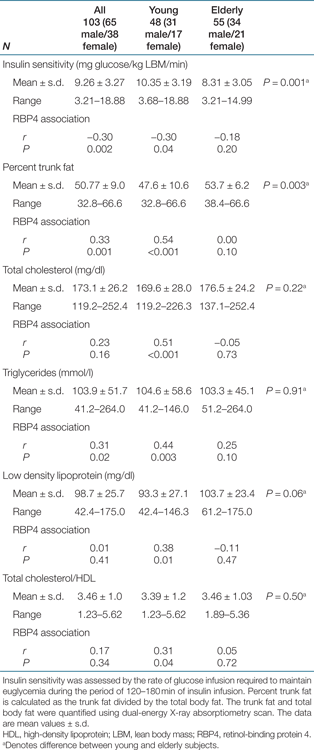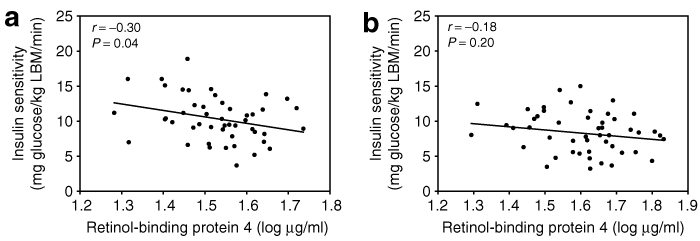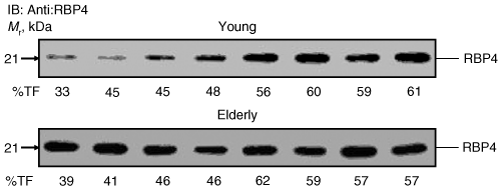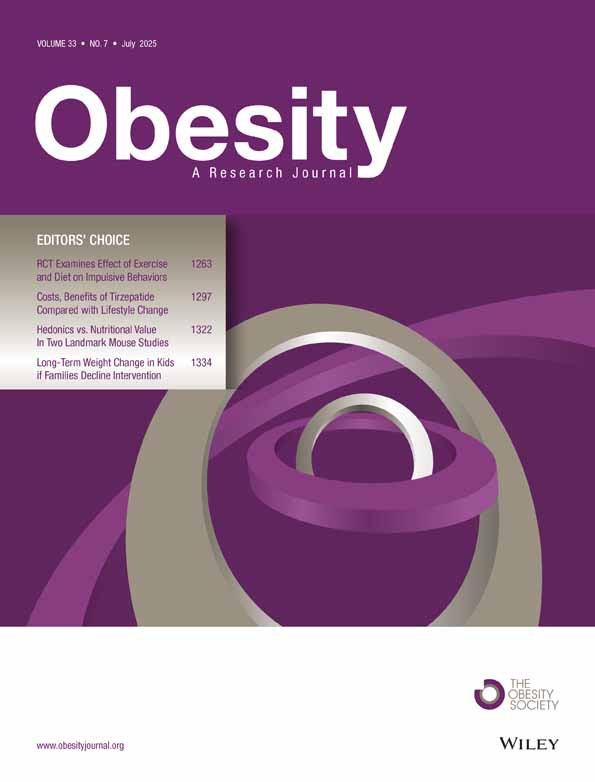Influence of Age on the Association of Retinol-binding Protein 4 With Metabolic Syndrome
Abstract
Objective: The relationships of retinol-binding protein 4 (RBP4) with insulin sensitivity and body fat distribution have been investigated in a few recent studies with conflicting results. This may have been due to differences in ages of the subjects in the different studies. The aim of this study was to investigate whether the association of RBP4 and insulin sensitivity and percent trunk fat are influenced by age.
Methods and Procedures: Cross-sectional analyses of 48 young subjects and 55 elderly subjects. Insulin sensitivity was determined by a hyperinsulinemic–euglycemic clamp. Body fat distribution was determined by a dual-energy X-ray absorptiometry (DXA).
Results: In the young subjects, RBP4 levels were associated with insulin sensitivity (r = −0.30, P = 0.04), percent trunk fat (r = 0.54, P < 0.001), triglycerides (r = 0.44, P = 0.003), low-density lipoprotein (r = 0.38, P = 0.01). In contrast, in the elderly subjects there was no correlation between RBP4 levels and insulin sensitivity (r = −0.18, P = 0.20), percent trunk fat (r = 0.00, P = 0.10), triglycerides (r = 0.25, P = 0.10), and low-density lipoprotein (r = −0.11, P = 0.47).
Discussion: The associations of RBP4 with insulin sensitivity, percent trunk fat, and lipid levels are influenced by age.
Introduction
Adipose tissue has been demonstrated to secrete various adipokines, which relate to insulin resistance (1). A new addition to the list of adipokines includes retinol-binding protein 4 (RBP4) (2,3,4,5). In animal studies, overexpression of RBP4 causes insulin resistance (1). In contrast, increasing urinary excretion of RBP4 in mice improved insulin resistance (1). Initial reports in humans revealed strong correlations to insulin resistance and features of metabolic syndrome (2). However, several subsequent studies in subjects with obesity or diabetes failed to identify a relationship between RBP4 and insulin sensitivity (1,5,6). In the largest study to date of 473 subjects, an association of RBP4 and insulin sensitivity was not detected (5). Interestingly, this study included subjects considerably older, with a mean age of 64 years (5). We therefore investigated whether the associations of RBP4 with insulin sensitivity and features of metabolic syndrome are influenced by age.
Methods and procedures
Insulin sensitivity was determined by a hyperinsulinemic–euglycemic clamp (7). Body composition was determined by a dual-energy X-ray absorptiometry (DXA) scan (Hologic, Bedford, MA). Percent trunk fat was calculated as the amount of fat in the trunk divided by total body fat. Serum RBP4 levels were measured by human enzyme-linked immunosorbent assay kits of the same lot number (ALPCO Diagnostics, Salem, NH, lot no. 060622, cat no. 30-6110, Exp 1/24/07) (3). The coefficient of variation within each assay was <5%. The coefficient of variation between assays was <10%. Expression of RBP4 was also established by immunostaining of western blots prepared from SDS–polyacrylamide gel electrophoresis with anti-RBP4 antibody (Dako, Carpinteria, CA) as previously described (8). All data are presented as mean ± s.d.
Results
Subjects included 48 young subjects (20–50 years) and 55 elderly subjects (60–83 years). Young and elderly subjects had similar BMIs (25.0 ± 2.7 kg/m2 vs. 26.0 ± 2.7 kg/m2, P = 0.07). The young subjects had a mean fasting glucose level of 92.9 ± 7.8 mg/dl, whereas the elderly subjects had a mean fasting glucose level of 99.4 ± 8.5 mg/dl (P < 0.001).
RBP4 levels were higher in the elderly subjects (42.0 ± 11.3 μg/ml, range 19.6–67.0 μg/ml) as compared to the young subjects (34.9 ± 8.0 μg/m, P < 0.001, range 25.5–52.5 μg/ml). This is consistent with prior work demonstrating elevated RBP4 levels in older individuals (2,4). In a multivariate regression analysis, the relationship between RBP4 and age was independent of insulin sensitivity (β = 0.41, P = 0.003).
Young subjects were more insulin-sensitive (10.4 ± 3.2 mg glucose/kg lean body mass/min) than elderly subjects (8.3 ± 3.1 mg glucose/kg lean body mass/min, P = 0.009) (Table 1). In the young subjects, RBP4 levels were inversely associated with insulin sensitivity (r = −0.30, P = 0.04) (Table 1a). In contrast, in the elderly the relationship of RBP4 levels with insulin sensitivity was not statistically significant (r = −0.18, P = 0.20) (1). RBP4 levels did not correlate with insulin resistance independently of percent trunk fat (β = 0.42, P = 0.003).
 |

: Correlation of retinol-binding protein 4 (RBP4) and insulin sensitivity in (a) young and (b) elderly subjects. Insulin sensitivity was assessed by the rate of glucose infusion required to maintain euglycemia during the period of 120–180 min of insulin infusion. LBM, lean body mass.
Young subjects had less fat distributed in the trunk (percent trunk fat) (48.6 ± 8.0) than elderly subjects (53.7 ± 6.2, P = 0.001) (Table 1). In an analysis of young subjects only, RBP4 levels were strongly associated with percent trunk fat (r = 0.54, P < 0.001) (2). This correlation of percent trunk fat and RBP4 levels in the young subjects was independent of insulin sensitivity (β = 0.50, P = 0.001). However, an analysis of RBP4 levels in the elderly subjects did not reveal an association between RBP4 levels and percent trunk fat (r = 0.00, P = 0.10) (2). To further evaluate the influence of age on the correlations of percent fat and RBP4 in the young and elderly groups, the standard asymptotic z-test was conducted after transformation of the data. The correlations of percent trunk fat and RBP4 were significantly different between the young and elderly (z = 3.17, P = 0.0015).

: Correlation of retinol-binding protein 4 (RBP4) and percent trunk fat in (a) young and (b) elderly subjects. Percent trunk fat is calculated as the trunk fat divided by the total body fat. The trunk fat and total body fat were quantified using dual-energy X-ray absorptiometry scan.
To confirm this data by another technique, RBP4 levels were determined by western blotting methodology as previously described (8). Consistent with the enzyme-linked immunosorbent assay data, overall the RBP4 levels were elevated in the elderly, as compared to the young subjects. In the young subjects, the RBP4 levels did increase with increasing percent trunk fat (r = 0.91, P = 0.02). In contrast, in the elderly, RBP4 levels did not increase with increasing amount of trunk fat (r = −0.03, P = 0.94, 3).

: Immunoblot (IB) analysis of retinol-binding protein 4 (RBP4) and percent trunk fat (%TF). Expression of RBP4 is assessed by western blot analysis with anti RBP4 antibody. Percent trunk fat is calculated as the trunk fat divided by the total body fat. The trunk fat and total body fat were quantified using dual-energy X-ray absorptiometry scan.
In the combined group of young and elderly, percent trunk fat correlated to the waist circumference (r = 0.27, P = 0.01) and the waist-to-hip ratio (r = 0.42, P < 0.001). However, percent trunk fat did not correlate to percent body fat (r = −0.11, P = 0.48. In addition, RBP4 did not correlate with total body fat in the young (r = −0.10, P = 0.48) or in the elderly (r = 0.02, P = 0.93).
In a comparison of young and elderly subjects, there was no significant difference in total cholesterol levels (169.6 ± 28.0 mg/dl vs. 176.5 ± 24.2 mg/dl, P = 0.22), triglycerides (104.6 ± 58.6 mmol/l vs. 103.3 ± 45.1 mmol/l, P = 0.91), low-density lipoprotein (93.3 ± 27.1 mg/dl vs. 103.7 ± 23.4 mg/dl, P = 0.06), and total cholesterol/high-density lipoprotein ratio (3.39 ± 1.2 vs. 3.46 ± 1.03, P = 0.50) (Table 1). In the young subjects, RBP4 levels were found to correlate to total cholesterol (r = 0.51, P < 0.001), triglycerides (r = 0.44, P = 0.003), low-density lipoprotein (r = 0.38,P = 0.01), and the total cholesterol/high-density lipoprotein ratio (r = 0.31, P = 0.04) (Table 1). In contrast, there was no correlation in the elderly between RBP4 levels and total cholesterol (r = −0.05, P = 0.73), triglycerides (r = 0.25, P = 0.10), low-density lipoprotein (r = −0.11, P = 0.47), and the total cholesterol/high-density lipoprotein ratio (r = 0.05, P = 0.72) (Table 1).
Discussion
In this study, we show for the first time that the association of RBP4 levels and features of metabolic syndrome are influenced by age. In young to middle-age individuals who are obese and/or with type 2 diabetes, a relationship of RBP4 to insulin sensitivity, waist-to-hip ratios, and dyslipidemia was reported (2,3). In contrast, a different study of 234 subjects found that RBP4 did not correlate with insulin sensitivity. Although the ages of subjects were not reported, the authors suggest that the lack of an association between RBP4 and insulin sensitivity may be due to differences in age between the subgroups (4). In a further study of 473 older subjects (mean age of 64 years, age range 41–90 years), there was no association of RBP4 with age or insulin sensitivity (5). The assays used to measure RBP4 in these two studies were not reported (4,5). This study of both younger and older subjects does not suggest assay variation among studies, but rather that there is a real difference in the relationship of RBP4 with features of metabolic syndrome between younger and older subjects. In young subjects, there is a strong association of RBP4 with insulin sensitivity, percent trunk fat from DXA measurements, and dyslipidemia. In contrast, there is no correlation between RBP4 levels and insulin sensitivity, percent body fat, or dyslipidemia in the elderly subjects. In this study, percent trunk fat was assessed by a DXA scan. The percent trunk fat includes subcutaneous abdominal fat and visceral fat. As such, conclusions about the correlations between visceral adipose tissue or subcutaneous abdominal fat and serum RBP4 cannot be made. This is a limitation of the use of a DXA scan. In addition, the subjects in this study were healthy adults; therefore, these results may not apply to individuals with comorbid medical conditions, or to individuals with differences in ethnicity (5).
In summary, the findings of this study suggest that age should be considered when interpreting the results of investigations of RBP4 and features of metabolic syndrome. These findings are also important in the design of future clinical studies relating to RBP4. An explanation as to why the relationship of RBP4 and features of metabolic syndrome are age dependent is a worthy area of future investigations.
Disclosure
The authors declared no conflict of interest.
Acknowledgments
This work was supported by NIH grant R01 DK49316-04 (to M.C.G.), R01 AG17446-01A2 (to M.A.M.), and NIH General Clinical Research Center Grant M01 RR10710-02, Clinical Research Scholar Program, Center for Translational Research, School of Medicine, Health Sciences Center, State University of New York at Stony Brook (to S.G.), and Empire Clinical Research Investigators Program (to M.M.M.). The authors also thank the nursing and core laboratory staff of the General Clinical Research Center for their assistance.





